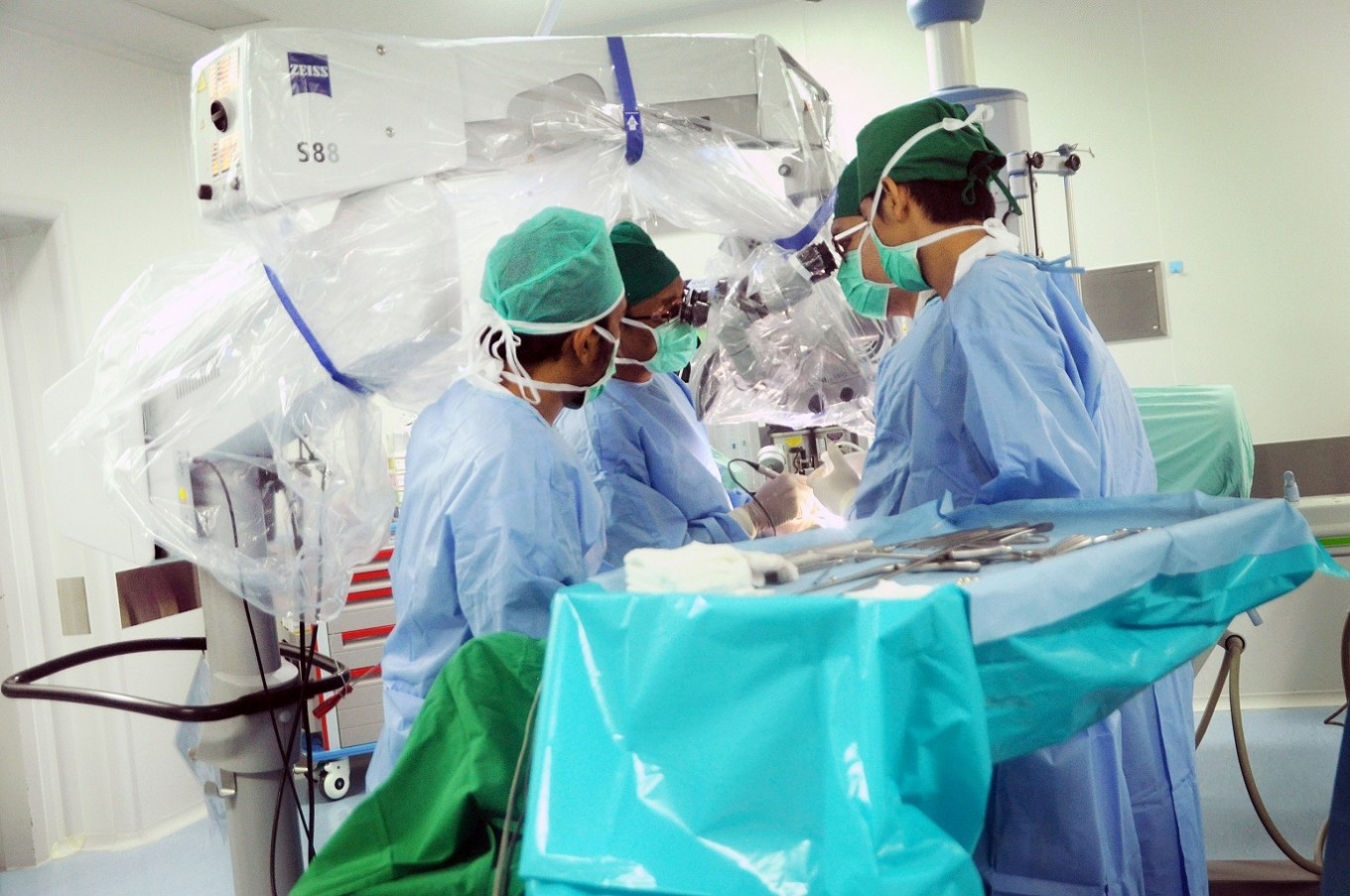'One day stand up, next day go home' with microsurgery
Advanced surgery techniques provide hope for patients fearful of postsurgery complications.
Change Size
 Work in progress: An operation is carried out using keyhole surgery at Persada Hospital in Malang, East Java.The procedure was conducted by three neurosurgeons, M. Sofyanto, Donny Wisnu Wardhana, and Benny Setiawan. (JP/Nedi Putra AW)
Work in progress: An operation is carried out using keyhole surgery at Persada Hospital in Malang, East Java.The procedure was conducted by three neurosurgeons, M. Sofyanto, Donny Wisnu Wardhana, and Benny Setiawan. (JP/Nedi Putra AW)
T
he reputation of Indonesian medicine is not strong with many Indonesians still flying out of the country to seek medical treatment abroad.
Agus C. Anab, a neurosurgeon affiliated with the Comprehensive Brain and Spine Center (CBSC) in Surabaya, East Java, says patients are even less convinced about the clinical handling of brain and neural diseases in the country.
“Advancements in medical technology in the past 10 years have actually enabled today’s physicians to conduct surgery with very small incisions,” he said.
This microsurgery applies the keyholesurgery technique, where surgeons perform surgery on a patient through a special microscope and endoscopic camera that can see clearly the internal structure of the brain or blood vessels. Adhesive bandages are then used instead of stitches for the incision.
“The process is known as ‘one day stand up, next day go home,’ so that the terrible things about brain operations, post-surgery bleeding and paralysis have become a tale of the past,” said Agus.
He had just conducted microsurgery on a cervical spondylosis or neck-bone degeneration patient at Persada Hospital in Malang, East Java.

Read also: The dangers of caffeine addiction
“The patient’s family can witness the surgery through a television monitor and make interactive communication with the team of physicians in order to be informed of what the team is doing,” he said. Such procedures are usually meant for patients with brain tumors, hemifacial (halfface) spasm, trigeminal neuralgia or severe pains of the gum, teeth and face, and lumbar spondylosis or lower backbone degeneration. Agus claimed this technique had prompted a number of patients to return to domestic treatment.
“Some of our patients even come from Hong Kong and Europe,” said the surgeon, who studied microsurgery in Germany and France. In East Java, patients are treated by seven CBSC neurosurgeons at three private hospitals: the Surabaya Surgery Hospital and Surabaya National Hospital in Surabaya; and Persada Hospital in Malang.
Agus hoped such treatments would be further developed. “This effort aims at building public confidence in our medical skills and equipment, which are not inferior to those offered abroad,” he said.
Read also: Cut your risk of diabetes through these lifestyle changes
The CBSC also works together with the Brain and Spine Community (BSC), initiated by Lilih Dwi Priyanto, a former hemifacial spasm patient and its members are volunteers, mostly comprising ex-patients in various regions in Indonesia.
“My face was once distorted and I felt pain for five years and through this community I help others not to undergo the suffering I did,” he said while assisting Agus at Persada Hospital. The 57-year-old is man fully recovered after his 2007 surgery. His recovery inspired him to share his experience through the community formed in 2009, by utilizing different means, from spreading information through bulletins, websites, and gatherings, to talk shows on electronic media as well as providing public education about brain and spine diseases.
In every bulletin and meeting, former patients’ testimonials are presented.
One of them is Sri Istiani, a 52-year-old from Gresik in East Java, who suffered from cervical spondylosis for seven years with severe shoulder and head pain.
Considerable sums were spent on medical and alternative treatments until finally Sri was recommended to have her ailment examined at the Surabaya Surgery Hospital. When she learned about her disease and the need for surgery, she became downhearted as she imagined paralysis following the neck-bone nerve operation. But Sri’s fears were unfounded. Only a day after the surgery, instead of being paralyzed, she could drive her car. Now she’s ready to devote her time and energy to the community organization to motivate other patients.

Lilih described the community’s attempts to maintain communication with sufferers so as to preserve their spirits and not to let them lose hope, while taking heed of their complaints.
“Through mutual contact, their ailments can be detected earlier for proper medical handling,” he said.
The BSC’s working principle is to make patients’ treatment procedures easier so there is no waste of time, energy or money.
The outcome has been remarkable, with hundreds of patients being cured every year through microsurgery. “They come not only from Indonesia but also from other countries,” Lilih said.
Regarding the surgery cost of tens of millions of rupiah, he tries to find a solution by lobbying community members who are better off to help relieve the burden of their sick fellow citizens.
Lilih also does not hesitate to consult CBSC doctors when dealing with low-income patients in the conviction that physicians can certainly use their discretion in facing such circumstances.
He hopes to keep on with this activity for the benefit of the public. “Our motto is ‘friends in time of sickness and best friends after recovery.’”









